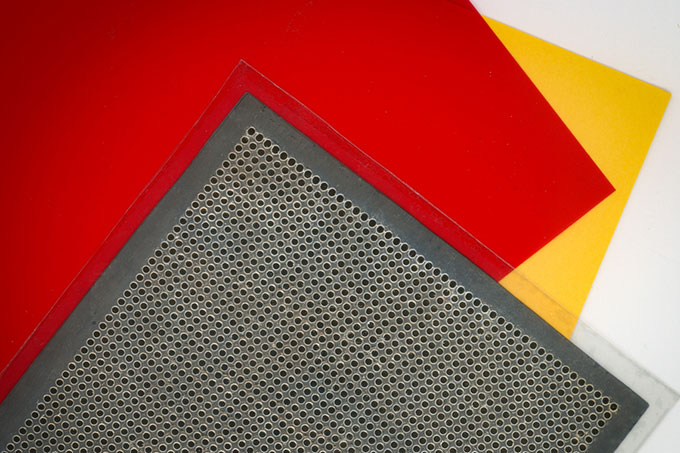You might someday ‘wallpaper’ your bedroom with this loudspeaker
The technology could also bring noise-canceling tech to fairly large spaces

Imagine having your favorite music immerse you as it’s broadcast throughout your room by the wallpaper. That’s one potential application of a new material being developed by engineers at MIT.
Becca Tapert/Unsplash
Share this:
- Share via email (Opens in new window) Email
- Click to share on Facebook (Opens in new window) Facebook
- Click to share on X (Opens in new window) X
- Click to share on Pinterest (Opens in new window) Pinterest
- Click to share on Reddit (Opens in new window) Reddit
- Share to Google Classroom (Opens in new window) Google Classroom
- Click to print (Opens in new window) Print
Noisy siblings? Loud construction right outside your window? A flexible new loudspeaker could help you rest easy. It could someday turn your walls into noise-canceling systems. And when you’re ready to liven things up, use the same wallpaper — or the surfaces of other ordinary objects in your room — to play music.
The new loudspeaker is super thin ― about as thick as a few sheets of paper. It’s lightweight and flexible enough to stick to most surfaces. It also produces high quality sound. And you can make it big, as in wall-sized, notes Jinchi Han. He’s an electrical engineer at the Massachusetts Institute of Technology in Cambridge.
At the heart of most speakers are moving membranes. An electric current makes them vibrate quickly. That sends nearby air molecules moving — and generating sound waves. Those vibrating air molecules are “the working principle for sound generation,” explains Han.
The new speakers don’t use such membranes. Instead, lots of dome-shaped microstructures cover their surface. The researchers start with a thin, flat sheet of some material. Then they use pressure to pull that material through openings in a template. This creates the dome shapes.
When squeezed, the material they use creates an electric charge. Such materials are known as piezoelectric (PEE-zoh-ee-LEK-trik). But applying an electric field across the material will also cause the domes to expand and contract, Han explains. That can vibrate nearby air molecules, generating sound.
Because the design is so flexible and durable, companies could potentially integrate speakers into T-shirts or other personal items. Or users could make their own.
Han and his colleagues describe their innovation February 15 in IEEE Transactions on Industrial Electronics.

You can put these speakers anywhere
Other researchers have created piezoelectric speakers. But none are like these. What’s special here are those micro-domes.
Old-style piezoelectric speakers broadcast sound waves through the motion of the whole speaker. Mounting such speakers onto a solid surface, Han says, would hamper their sound by restricting that motion.
Han’s team sandwiches their new material between two plastic sheets (to protect the domes). Tiny holes punched through the sheets line up in such a way that the domes can expand into these holes as they vibrate.
“The bottom layer elevates the small domes so that they can vibrate freely even if the speaker is mounted on a surface,” Han reports. They can vibrate even if the surface is rough or curved. The upper protective layer “is thicker than the domes are high,” he explains. So he notes that if you touch the surface, “you don’t need to worry about damaging these small structures.”
Han points to another benefit of this tech. Large expanses of the new material could make controlling noise a whole lot easier.
Noise-canceling systems already exist. Most detect sound waves in the environment and then generate new sound waves to “cancel” those out. But whether it works for a listener depends on where that listener’s ears are in relation to the approaching sound waves.
Trying to cancel noise this way everywhere inside a room would be tricky, Han points out. It would take lots of microphones and speakers, which can be bulky and expensive.
Here, each dome works as a tiny speaker. The domes can generate sound waves all together, in groups or individually. Wallpapering your bedroom with this material would create speakers all around you. Those same speakers also could dampen — or cancel — unwanted sound. When desired, you could turn any space into “a quiet zone where you could sleep or study without too much noise,” Han says. He also sees applications in cars, airplanes, apartments or anywhere unwanted noise is a problem.
Another plus? The new design costs far less and uses less energy than conventional speakers.
The researchers built a prototype — a sheet of the material that’s 10 centimeters by 10 centimeters (about 4 inches by 4 inches). The piece has more than 8,000 domes. Super-sizing the design would be straightforward, Han says. But first his lab needs to get some new tools.
Large versions could be the next step for immersive, or 3-D, sound experiences, says Lori Beckstead. She teaches audio and digital media at Toronto Metropolitan University in Ontario, Canada. She’s also a sound artist.
In an immersive sound experience, sounds seem to come from all directions. Such designs can help people fully engage in performances, virtual-reality scenarios, museum exhibits and other experiences. The new speakers are so thin and light they “could be placed in spaces where traditional loudspeakers might have been impractical,” Beckstead adds.
And that doesn’t just apply to immersive sound. She notes that adding noise-canceling technology to loud spaces — from restaurants to noisy manufacturing plants — would be fantastic. “Poorly designed sound environments can be detrimental to anything from mental health to productivity to mood.”







